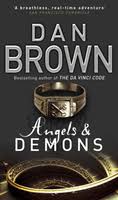 |
The cover in which
I read the book |
So, I finished reading Angels & Demons. The flow pattern of the story is different from The Da Vinci Code -- instead of gripping action throughout, this book has a long period of cool tension; they know when the cardinals will die, when the antimatter canister's battery will die down. The instant of the danger looming is perfectly pinpointed, and the danger is inevitable unless they solve the puzzles correctly. Compared to Da Vinci Code, less research and code-breaking, more mature emotions, more bloody narrative, more sad deaths. And, oh my god, hypocrisy, hypocrisy. Nearly everyone turns out to be something different from what they had seemed to be -- had I not known Langdon and known this to be a prequel, I'd have half-expected him to show an unexpected side of himself. Also, it's less inclined towards one ideology and has a more global and practical approach to the intricacies of religion in the modern world. Just like Da Vinci Code, though, it leaves a loose end, and does this in a less skillful way than the other book. In the Da Vinci Code the reason for the inconclusiveness of the quest was successfully made convincing and did not seem abrupt at all. In Angels & Demons, however, the hiding of the truth didn't touch me that well and also it was a little bit more abrupt than I would have liked. Maybe the warlike strain in the title had made my subconscious expect more of a clear-cut win for the Angels.
 |
The title written in ambigram, a
powerful visual and symbologistic
feature used in the book (this ambigram
with different or no ornamentation
has been used in the book's other
covers and related merchandise). |
Initially I had thought maybe all four cardinals won't be killed, but then it struck me that Dan Brown would surely show us all the ambigrammatic brands, and what easier way than to let the killings happen and the Hassassin be caught at the last moment. The killings and the adventure took up too much more of the book that the conclusion -- the ratio was too skewed for my taste. Also, unlike in Da Vinci Code, the ending was hardly related to the adventure itself. It concerned Landon, Vittoria and a hotel room -- spoils the intellectual satisfaction of a food-for-thought, adventure-rich book , if you ask me. Not against consenting adults, but surely against handing them the all-important last page. I wonder if Langdon the confirmed devotee of free bachelorhood sleeps with yet someone else in the last book. One more interesting thought: most probably the author had the idea of the prequel in his head, maybe even had written it when the wrote the Da Vinci Code: the references in it to this book were pretty solid. I think he realised that one would sell more and help up this one and the prequel.
Sad casualties: Leonardo Vetra (not so sad as the narrative is based on his murder), Max Kohler, the Pope, Olivetti, Rocher, the folio from Galileo's
Diagramma, the archives Langdon had to knock down, the four cardinals. Last I checked, that's a lot.
I read just a few pages of the Lost Symbol. Going slow and giving my brain a break from Langdon and his creator.
For people new to ambigrams, check out the
Wikipedia page on them, and note that the ambigrams used in this book (and the title ambigram above) are rotational ambigrams that read the same way turned upside down.
Images: Google




0 comments:
Post a Comment
Speak and you will be heard.